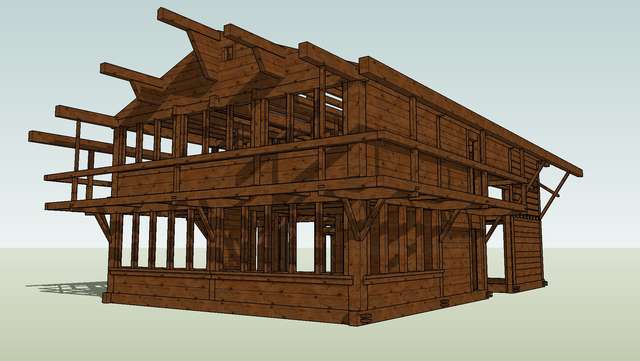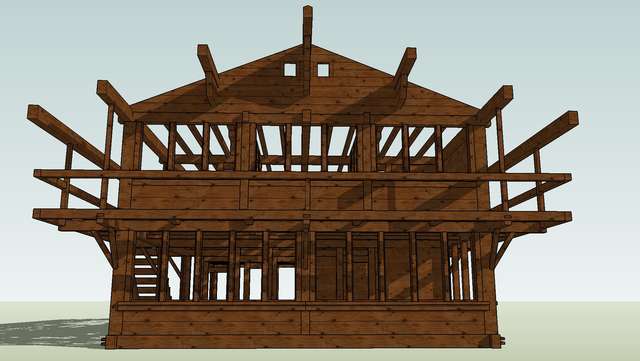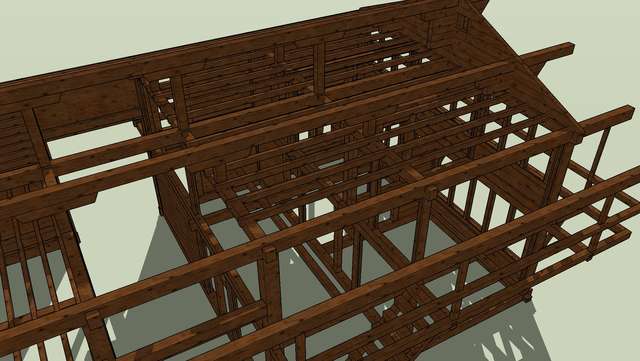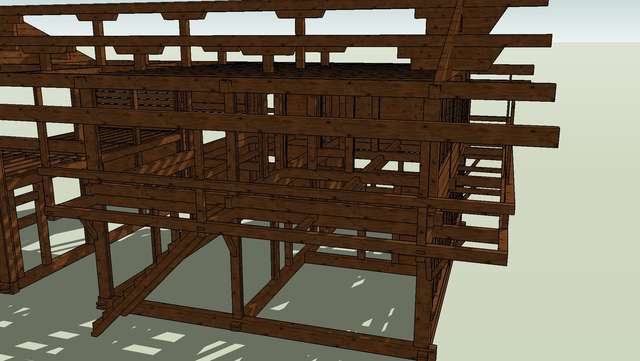The next style of framing is a mixture of log and timber technologies, resulting in something entirely new:








Here I have executed part of the structure with the log infills and window framing that go along with the overall style, but also omitted these on another part to show the basic framing more clearly.
This structure is divided into two sections separated by an open hallway (called a Tenn) but united under a common roof. The front section is a house while the rear is a barn. It is common to see these two sections framed in different styles, as shown here. It's not completely understood why this is the case, although the two section were usually built at different times. The arrangement shown here, with a platform-framed house and a tall-posted barn, is very common, owing likely to the fact that the barn is usually framed more crudely. The barn is also not usually a hybrid, but is a pure timber frame. (One theory is that the two framing styles are evidence of the two different cultures that settled this region combining to create something new and unique.
This structure actually does a decent job of illustrating both the hybrid construction style of the subalpine ranges and the timber framing style of the Swiss Plateau if the two halves are examined separately.
Like the previous method of construction, this is a method of platform framing. This possesses a distinct advantage over the timber framing styles of the plateau in that the layout of the rooms above are not bound to the layout of the rooms below. This is a concept learned from log building. Here we see on the front there are two room on the ground level and three rooms above. This building possesses log gables atop a timber frame. This used to be common and 150 years ago would have been found all over the northern verge of the Alps, but today most of these structure are gone -the log gables replaced with steeper timber framed roofs- and only a handful remain.
This particular style illustrated here uses a double beam assembly where the two stories meet, but this is not the only way it is done (although it is the way I like the best) some use a single timber here, joined on a single level still.
As far as heavy timber framing goes, this is my absolute favorite, with or without log infill. In its home region, this sort of framing is always seen with heavy timber infill as shown here, because it is actually an adaptation of the older log building tradition. I can't give any dates on when this developed, only to know its heyday seems to have been about the 16th century, and much older examples still exist. This to me along with the history of settlement suggests this style began to develop as early as the 8th century, when settlers from the north began to arrive in the region already settled by people from the Alps to the south. The former carried with them timber framing techniques into a region dominated by log building (we see a declining influence of timber framing the further south we go, with a few scattered examples existing in the mountains such as the dominance of a timber framed lower story and log built upper story in the Simmental region, and the rare occurrence of timber framed roofs atop log structures dating from the 16h century and earlier)